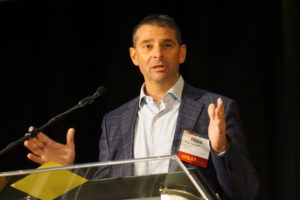
How do banks remain relevant in an environment of disruption and disintermediation? That was the central question posed by Ross Manson, Eide Bailly’s chief innovation officer, who led a panel discussion at the company’s banking seminars, conducted Oct. 30 in Fargo, N.D., and on Nov. 1 in Mankato, Minn.
Quoting General Eric Shinseki, Manson said: “If you don’t like change, you’ll like irrelevance even less.” Manson’s job is to help banks instill the “discipline” necessary to innovate. “It doesn’t happen overnight; there is an approach to this and you have to inject it if you’re going to innovate,” he said.
You can start by creating an awareness of innovation throughout the organization, he said.
“Introduce new thought leaders, bring in new articles, and consider new seminars or conferences to attend outside the norm,” he said. This newness will lead to greater intelligence at the organization, which should drive greater inspiration and creativity. “All of it will lead you to find the solutions you will need in the future, he said.
Manson suggested creating a platform through which an organization could crowdsource ideas. “Give people an opportunity to generate ideas without getting squashed by direct reports, which happens all too often today,” he said.
A framework for ideas is also critical. Once an idea is brought forward, people need to think about how it works, what it looks like, and what if feels like. A thorough understanding of all ideas by the team needs to occur before upper management will get behind the idea.
The Eide Bailly innovation platform is called “IdeaHub.” Manson said once it was operational, 990 ideas were submitted through web portal, ideas “that would not have matriculated up.” Manson advises though that if you open up a platform, management needs to respond to all ideas, regardless of whether the ideas have merit.
Manson said they categorized innovations as 1) innovations on internal structures; 2) innovations on products and services; and 3) innovations around customer experiences.
Collecting ideas has given the accounting firm a deeper understanding of where its organizational maturity is found. Manson said some of the barriers to innovation are:
- Comfort with the status quo.
- Too many strong silos.
- Adherence to legacy processes.
- Lack of thought diversity. When you inject new people into the decision-making process, Manson said, you’ll find new ideas will emerge faster than they do currently. “If you surround yourself with the same people, you won’t advance your ideas far enough and fast enough,” he said.
- Lack of customer focus.
In every conversation around innovation (and disruption), Manson suggested people think proactively. Innovation needs to be “injected” into an organization, he said.
